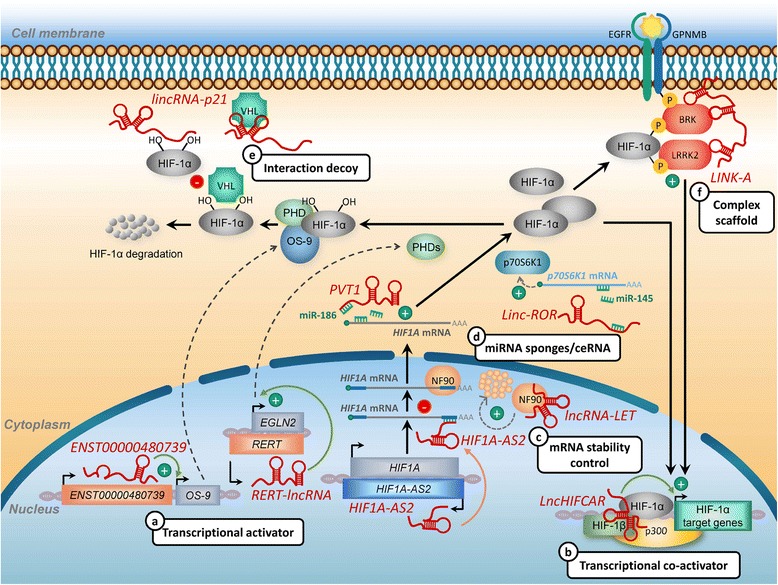Fig. 2.

Mechanisms of hypoxia-reponsive lncRNAs affecting HIF-1α activity. a Transcriptional activator. lncRNA ENST00000480739 suppresses HIF-1α expression by upregulating OS-9 transcription. OS-9 is a HIF-1α-binding protein that facilitates HIF-1α hydroxylation and proteasomal degradation. Another lncRNA RERT-lncRNA decreases the HIF-1α levels by upregulation of EGLN2 mRNA. EGLN2 encodes prolyl hydroxylase PHD1, which is responsible for HIF-1α hydroxylation and promoting HIF-1α degradation. b Transcriptional co-activator. LncHIFCAR acts as an oncogenic HIF-1α co-activator through direct binding to HIF-1α, thereby facilitating the recruitment of HIF-1α and p300 cofactor to the target promoters and stimulating HIF-1 target gene expression. c mRNA stability control. lncRNA-LET interacts with RNA-binding protein NF90, which has been implicated in the stabilization of target mRNAs. As the association between lncRNA-LET and NF90 could enhance the degradation of NF90, the hypoxia-induced downregulation of lncRNA-LET may thereby increase HIF-1A mRNA stability under hypoxic conditions. In addition, lncRNA HIF1A-AS2, an antisense transcripts transcribed from the 3′-UTR of the sense HIF1A mRNA negatively regulates HIF1A mRNA expression. Through base-pair binding to the HIF-1A mRNA 3′-UTR, HIF1A-AS2 could expose AU-rich elements within the HIF-1A mRNA 3′-UTR, thereby destabilizing of HIF-1A mRNA. d miRNA sponge/ceRNA. miR-145 negatively regulates expression of p70S6K1, a protein kinase responsible for promoting protein synthesis. Hypoxia-induced lincRNA-ROR could upregulate HIF-1α expression by sequestering endogenous miR-145. In addition to lincRNA-ROR, PVT1 lncRNAs upregulate HIF-1α expression by sponging miR-186. e Interaction decoy. lincRNA-p21 is capable of binding to both VHL and HIF-1α, leading to disruption of VHL/HIF-1α interaction. f LINK-A recruits and activates BRK and LRRK2 to phosphorylates HIF-1α. These phosphorylation modifications prevents HIF-1α degradation under normoxia and facilitates the interaction between HIF-1α and cofactor p300, thereby activating HIF-1 target genes. See text for detailed discussion
